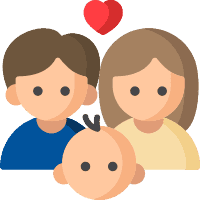As toddlers grow, they become expert experimenters with all kinds of noises. Around the age of two, your kiddo will probably start testing out G and K sounds. This can be very exciting for parents! There’s a very specific and profound joy that comes from hearing your child successfully enunciate words like “go” or “cat.” They grow up so fast, and speech is part of that growth!
But it’s also understandable to have questions. What if you notice your toddler using T sounds instead of K sounds (asking for a “tootie” (cookie) for example)? What if your toddler is turning four and still has difficulty enunciating G sounds?
Knowing what’s typical in developing G and K sounds in toddlers is often a huge relief for parents. Information about baselines can help you know when you might want to step in to help or seek additional treatment from a pediatric speech language pathologist.
How G and K Sounds are Created
The G and K sounds are both created in a very similar fashion (that’s why they tend to develop around the same time):
-
- K sound: The tongue is drawn into the mouth so that the back of your tongue touches the soft palate (essentially, the back of the roof of your mouth). Then, air is released as the tongue drops, creating the hard K sound. Your vocal cords are not involved in making a K sound–the quick release of air does all the work.
- G sound: The tongue placement and movement is the same for a G sound as it is for a K sound. The only difference is that your vocal cords are activated to make the G sound.
Both the G and K sounds are examples of “stop consonants,” which means that sound is produced by stopping and starting airflow. (You can try this for yourself. Notice that when you make a G or K sound, your tongue effectively restricts your outgoing air–even if only for a split second). Making both a G and a K sound depends on relatively strong muscles around the base of the tongue.
Your toddler should be pretty comfortable with G and K sounds by the age of three. If you notice some trouble getting the hang of these two sounds, however, there are some things you can do to encourage and build G and K sound skills.
Tips for Developing G and K Sounds
There are several ways that you can help your child practice G and K sounds in a way that’s fun and positive. Here are some things to keep in mind:
- Start small: Work with syllables before you move on to small words. For example, start with “Ka, ka, ka”. Once your toddler is able to enunciate the syllables, you can move on to small words, then larger words, and eventually phrases.
- Lead by example: When you’re trying to get your kids to pick up on G and K sounds (or any sound, for that matter), it’s important to give them plenty of examples. Emphasize the G and K sounds in everyday conversation. “Go, Go, Go to the store,” for example. “Say hello to the cat, cat, cat.” or “Ready, set, GO!” Make sure you enunciate clearly, slowly and repeat the sounds so your toddler can hear them.
- Start with K: For most toddlers, it’s going to be easier to develop the K sound than the G sound. That’s because the K sound can be whispered–so it’s easier to start small and work your way up. If your toddler is more comfortable working with G first, then it’s all right to focus there.
Activities That Will Help
There are several at-home activities designed for developing G and K sounds in toddlers. Some of the most popular such activities include the following:
- Growl and gurgle: One great way to practice the G sound is to employ it when doing two specific vocal activities: growling and gurgling. Use the “grrr” sound to playfully help your kiddo practice the G sound. For example, you can take turns growling like a dinosaur or a puppy dog. (Be sure to emphasize the play and de-emphasize aggressive connotations to the sound.) Or, when you’re brushing your child’s teeth, have them gurgle some water. Gurgling uses the same tongue position as enunciating the G or K sounds. Once wet gurgling has been accomplished, you can try dry gurgling–getting really close to that G sound.
- Ready, set…: Games that involve starting and stopping can be helpful, too. You say “ready, set” and your toddler gets to say, “Go!” Rolling cars around on the floor and making them “GO!!!”
- Lay on the ground and look up: If your kiddo is having trouble with the G or K sound, it may have something to do with an inability to find the correct tongue position. That’s where laying on the ground can really help. When you lay on your back, your relaxed tongue will naturally fall to the soft palate. This can help your toddler get a sense of where the tongue should be placed when making G and K sounds. Once in that position you can play with growling or saying words that start with the g or k phoneme.
Toddlers learn language via interactivity. So whatever activity feels best to you, it’s essential to emphasize the interactions between you and your toddler.
Get Help From a Speech Language Pathologist
Developing G and K sounds in toddlers can be a challenge, requiring tongue strength and dexterity. If these tips and tricks don’t work, you should talk to a speech language pathologist, who will have access to more sophisticated treatment approaches.
Try these techniques out on your own! If you have difficulties, please contact us to schedule an appointment.


